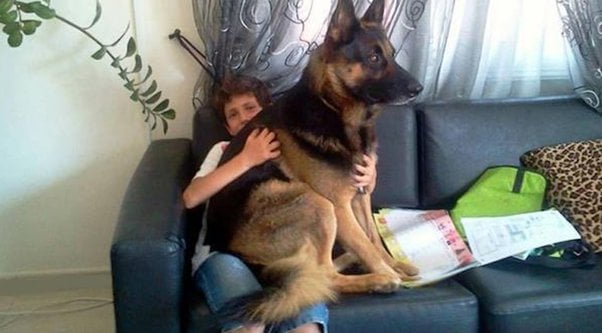Have you ever wondered why your furry companion always chooses to sit right in front of you? It’s a common behavior that many dog owners have observed, and it can be both endearing and puzzling at the same time. In this article, we will delve into the possible reasons behind Why Does My Dog Sit in Front of Me and explore the fascinating dynamics between dogs and their human counterparts.
Dogs have been our loyal companions for thousands of years, and their ability to form strong bonds with humans is unparalleled. When your dog sits in front of you, it is likely a display of their deep affection and desire for connection. Dogs are pack animals by nature, and by sitting in front of you, they are instinctively positioning themselves as a member of your pack, seeking your attention and approval.
 The Fascinating Behavior: Why Does My Dog Sit in Front of Me?
The Fascinating Behavior: Why Does My Dog Sit in Front of Me?
Here are some of the reasons of Why Does My Dog Sit in Front of Me:
1. The Need for Connection
Dogs are known for their unwavering loyalty and their ability to form deep emotional bonds with their human companions. When your dog chooses to sit in front of you, it is often a clear indication of their desire for connection. Dogs are social animals, and by positioning themselves in front of you, they are seeking your attention, affection, and companionship. This behavior is a testament to the strong bond you share with your furry friend.
2. A Display of Trust and Security
One of the reasons why your dog may prefer to sit in front of you is to establish a sense of security. Dogs are highly attuned to their surroundings and instinctively seek a safe environment. By sitting in front of you, your dog can keep a watchful eye on you, ensuring their own safety while also relying on your presence for reassurance. It’s their way of saying, “I trust you to protect me, and I feel safe when I’m close to you.”
3. Respect and Submission
Dogs are pack animals with a hierarchical structure ingrained in their instincts. By sitting in front of you, your dog is showing respect and acknowledging your role as the leader of the pack. This behavior is a display of submission, as they position themselves in a lower posture to convey their recognition of your authority. It is a way for your dog to reinforce the bond and establish a harmonious relationship within the pack.
4. Reading Your Cues and Emotions
Dogs are remarkably perceptive creatures and have an innate ability to read human body language and emotions. When your dog sits in front of you, they are in a prime position to observe your facial expressions, gestures, and overall demeanor. This allows them to pick up on your mood and respond accordingly. Whether you’re feeling happy, sad, stressed, or excited, your dog is attuned to your emotional state and will often offer comfort and support.
5. Practical Recommendations
To strengthen the bond with your dog and enhance the positive aspects of this behavior, here are some practical recommendations:
- Quality Time: Dedicate regular quality time to spend with your dog. Engage in activities such as walks, play sessions, or training exercises. This will help fulfill their need for attention and strengthen your connection.
- Positive Reinforcement: Reward your dog with praise, treats, and affection when they exhibit desired behaviors, including sitting in front of you. This will reinforce the behavior and make it more likely for them to continue seeking your presence.
- Communication: Pay attention to your dog’s body language and vocalizations. Learn to understand their cues and respond appropriately. This will foster effective communication and deepen your understanding of each other.
- Comfortable Space: Provide your dog with a comfortable and safe space near you. This can be a designated bed or a cozy spot close to where you spend most of your time. Having their own special place nearby will make them feel secure and content.
- Training and Socialization: Enroll your dog in obedience training and socialization classes. This will not only help them learn proper behavior but also expose them to different situations and people, further strengthening their confidence and trust in you.
Practical Recommendations for Fostering a Strong Bond with Your Dog
1. Quality Time and Engagement
Dedicate regular quality time to spend with your dog. Engage in activities that promote bonding, such as daily walks, interactive play sessions, or training exercises. This dedicated time together will not only provide physical exercise but also strengthen the emotional connection between you and your furry friend.
2. Positive Reinforcement and Reward-Based Training
Utilize positive reinforcement techniques to encourage desired behaviors, including sitting in front of you. Whenever your dog exhibits this behavior, offer verbal praise, gentle petting, or small treats to reinforce their actions. Consistency and positive reinforcement will help them understand that sitting in front of you is a behavior that is valued and rewarded.
3. Effective Communication and Understanding
Pay close attention to your dog’s body language and vocalizations. Learn to understand their cues and respond appropriately. By being attuned to their needs and emotions, you can create a deeper level of communication and understanding, strengthening the bond between you and your dog.
4. Provide a Comfortable and Safe Space
Ensure that your dog has a designated comfortable and safe space near you. This can be a cozy bed or a designated spot close to where you spend most of your time. Having their own special place nearby will make them feel secure and content, further reinforcing their desire to be in your presence.
5. Obedience Training and Socialization
Enroll your dog in obedience training and socialization classes. These activities not only help them learn proper behavior but also expose them to different situations, people, and other dogs. Through training and socialization, your dog will gain confidence and trust, strengthening their bond with you as their trusted leader.
6. Patience, Love, and Understanding
Remember that building a strong bond with your dog takes time and patience. Show them love, compassion, and understanding in all interactions. Be patient with their learning process and provide gentle guidance. This will create a nurturing environment where your dog feels safe and loved, deepening the connection between you both.
7. Seek Professional Help if Needed
If you encounter challenges in understanding or addressing your dog’s behavior, do not hesitate to seek professional help from a certified dog trainer or behaviorist. They can provide expert guidance tailored to your specific situation, helping you navigate any obstacles and further strengthen the bond with your furry companion.
 By implementing these practical recommendations, you can enhance the bond with your dog and create a loving and fulfilling relationship based on trust, respect, and companionship. Enjoy the journey of understanding and connecting with your furry friend, as they continue to sit in front of you, seeking your love and companionship.
By implementing these practical recommendations, you can enhance the bond with your dog and create a loving and fulfilling relationship based on trust, respect, and companionship. Enjoy the journey of understanding and connecting with your furry friend, as they continue to sit in front of you, seeking your love and companionship.
Why Does My Dog Sit in Front of Me – Conclusion
The behavior of a dog sitting in front of you is multi-faceted and reflects their need for connection, trust, and security. It is a display of respect, submission, and their ability to read and respond to your emotions. By understanding and appreciating this behavior of Why Does My Dog Sit in Front of Me, you can nurture a strong and fulfilling relationship with your beloved canine companion. Remember to provide them with love, attention, and positive reinforcement, and enjoy the unique bond you share.















 The Fascinating Behavior: Why Does My Dog Sit in Front of Me?
The Fascinating Behavior: Why Does My Dog Sit in Front of Me?






